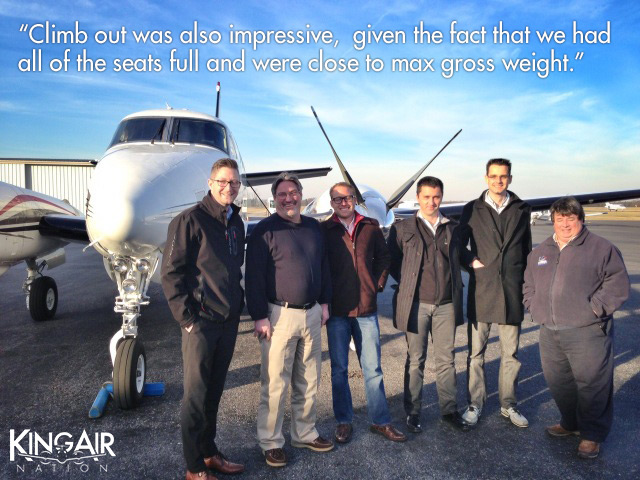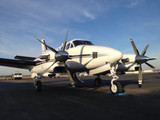
We all know General Electric has a rich aviation history, but the family tree has never fully branched out to the King Air line until now. KingAirNation was on hand to experience this high-performance aircraft with its first media debut.
It was sunny outside – perfect flying weather. It was a cool, January afternoon in Smyrna, Tennessee as we boarded Smyrna Air Center’s first GE H80-powered King Air C90 [N4447W] on behalf of KingAirNation to take a flight in the recently certified aircraft – an experience KingAirNation is proud to be among the first in the world to be a part of.
Also along for the ride and review was Smyrna Air Center’s French Authorized Install Facility, Aeromecanic, who was recently added to Smyrna Air Center’s growing global list of authorized installation facilities. Aeromecanic owns a 1979 King Air C90, which allowed for a great comparison of the two aircraft.
Curb-Appeal
The first thing we noticed about the aircraft while on the ground was the propeller and engine placement. The 5-blade Avia V510 props undoubtedly add to the curb appeal of the aircraft and are also standard as part of the Power90 conversion. Smyrna Air Center says the propellers are about as easy to install and maintain as any. In fact, should one need to repair a blade, that one blade can be removed and sent for servicing rather than one having to remove and send the entire prop, which saves on shipping expenses. Additionally, the company says the installation and removal is far easier than others due to its unique installation ring.
The King Air C90 was also supported with some of Raisbeck Engineering’s products, including Wing Lockers and Dual Aft Body Strakes. Smyrna Air Center says they prefer to send the planes out the door with these products installed, although the “turnkey” conversions do not require them.
The engines are about 4 inches more forward than the standard factory engines. This, in addition to the 5-bladed props, meant incredible noise reduction in the cabin for us as we were flying. Once we were airborne, we were able to carry on a conversation in the back of the aircraft without any increase in my voice intensity.
Flight Features
The engine-start is interesting. An on-board computer starts the engines, which reduces the chance of a hot start. Also, charter operators who may have multiple pilots flying the same plane, the computer removes “pilot-specific technique” from the equation. With the toggle of a switch and a few second’s wait, the pilot will hear the smooth song of the H80’s.
The takeoff run reminded me more of a jet, in terms of acceleration. Climb out was also impressive, given the fact that we had all of the seats full and were close to max gross weight. The aircraft’s maximum takeoff weight (MTOW) increases from 9,650 to 10,100lbs with the addition of the Raisbeck aft strakes.
The initial climb was near 2000 feet per minute through 8000, and then the climb continued at 1400 feet per minute until flight level 230. Although we did not take the plane to FL 280, Smyrna Air Center tells me the aircraft will climb from the runway to 28,000 feet in under 18 minutes. Also, the advantage of having 800 HP engines operating on a 550 HP airframe means the engines are never really being pushed hard so they will maintain maximum torque all the way to 28,000 feet. During the flight-testing, the pilot feathered one engine at 21,000 feet and the plane maintained altitude at 150 knots, indicated. This means that the aircraft can meet minimum en route altitude (MEA) requirements anywhere in the U.S. and most other countries.
In a very comfortable way, the Power90 cruised at 250 knots (true air speed) with very reasonable fuel consumption. When throttled back to 230 knots, the fuel consumption is 100lbs per hour LESS than the stock PT6A-21 for the same cruise speed. The Power90 guys tell me to expect 262 knots or better cruise speed (although they say they have seen 290 knots but won’t yet claim this as the everyday cruise speed). Aeromecanic attested, “we were flying fast for the cost of a PT6A-21 version in a near-jet cabin experience.”
The Power90 conversion includes an isolation switch that, in case of a Fuel Control failure, allows the operator to isolate the controller and continue to run BOTH engines. The engine with the failed Fuel Control Unit only has about 80% power, but will continue to run, rather than the operator having to shut the engine down. This certainly appears to be a unique safety feature of the H80’s.
 The avionics installed by Smyrna Air Center was really spectacular. Basically, it was nearly an all-Garmin glass panel with Dual Garmin G600 MFD/PFD/AHRS, ADS-B Compliant Garmin GTX-330ES Mode S Transponder, Garmin GWX-70 Color Radar, Garmin 530W GPS, and a GDL-69 Satellite Weather Downlink. We remember the Power90 601 demonstrator that had an equally impressive all-glass panel, installed by Smyrna Air Center. With the new H80-powered aircraft being used for flight demonstrations, the former demonstration aircraft is currently for sale, by the way.
The avionics installed by Smyrna Air Center was really spectacular. Basically, it was nearly an all-Garmin glass panel with Dual Garmin G600 MFD/PFD/AHRS, ADS-B Compliant Garmin GTX-330ES Mode S Transponder, Garmin GWX-70 Color Radar, Garmin 530W GPS, and a GDL-69 Satellite Weather Downlink. We remember the Power90 601 demonstrator that had an equally impressive all-glass panel, installed by Smyrna Air Center. With the new H80-powered aircraft being used for flight demonstrations, the former demonstration aircraft is currently for sale, by the way.
It’s always nice to get to altitude quickly, stay on top of the weather, and get to the destination fast. There seems to be no question that the Power90 delivers on the performance parameters.
Maintenance
As exciting as the performance of the plane is, what we really find interesting is the substantial reduction in downtime and maintenance-related costs these engines offer. The H80’s have the same TBO as Pratt & Whitney’s PT6A-135A’s but do not require hot section, ever! Blake Tumbleson, Director of Sales and Marketing for Smyrna Air Center says “it’s simple, you go from zero to TBO”. Additionally, the H80 utilizes a unique slinger ring design eliminating the need for fuel nozzle overhauls; something that is required every 400 hours on comparable PT6 engines. A reduction in down time and maintenance means decreased cost of ownership.
The GE H80-Powered Power90 King Air delivers! It offers performance, cost savings, comfort, and safety.

For more information on the Power90 Conversion, you can contact Smyrna Air Center’s representatives below:
Dan Sigl
Director of Power90 Business Development
Technical Expert/STC SA10071SC
(615) 971-8107
Dan.Sigl@SmyrnaAirCenter.com
or
Blake Tumbleson
Director of Sales and Marketing
Smyrna Air Center, Inc.
(615) 948-0008
blake@SmyrnaAirCenter.com

